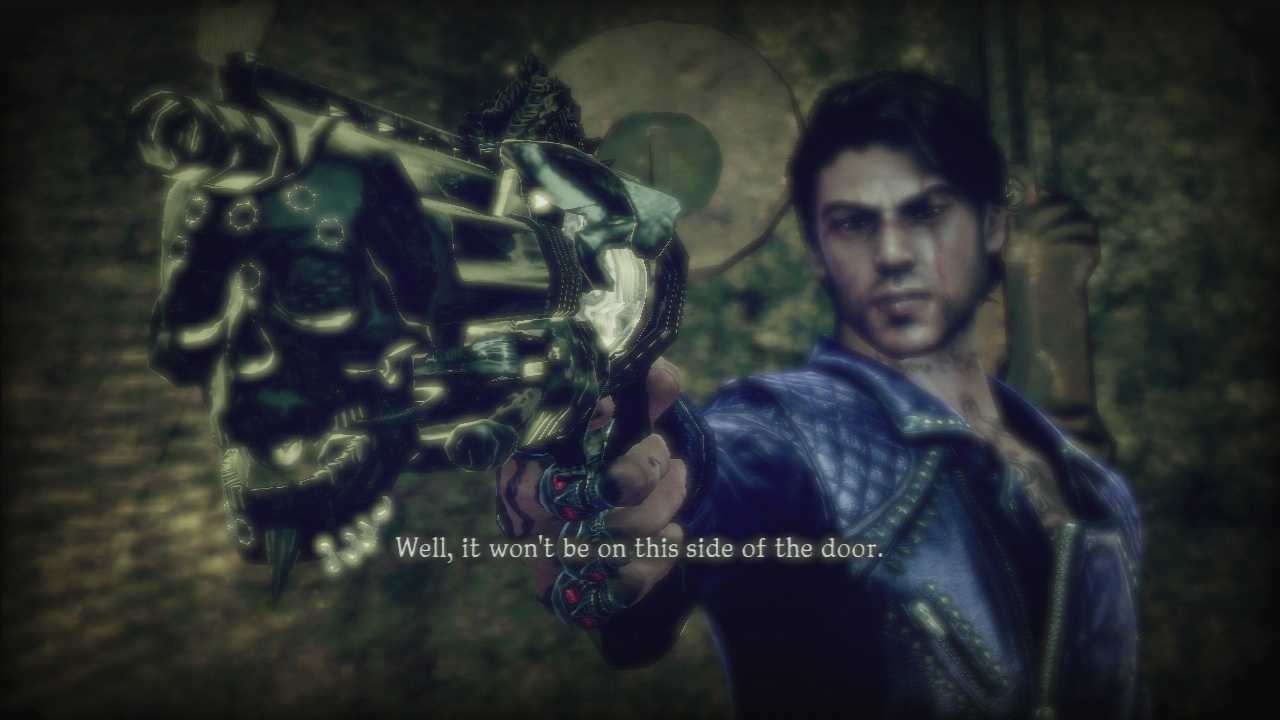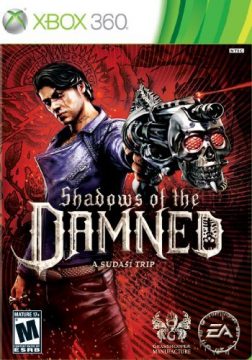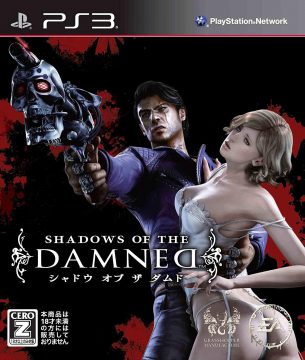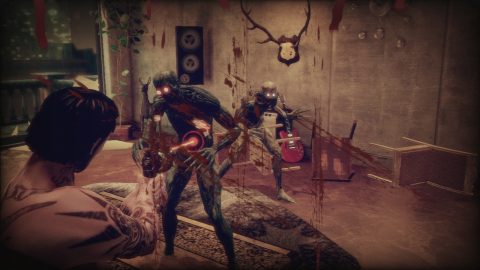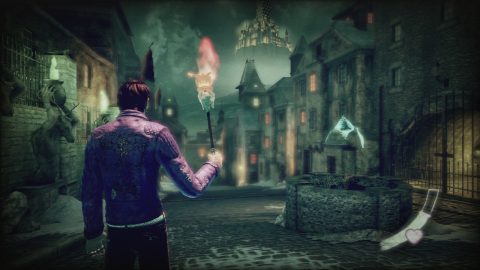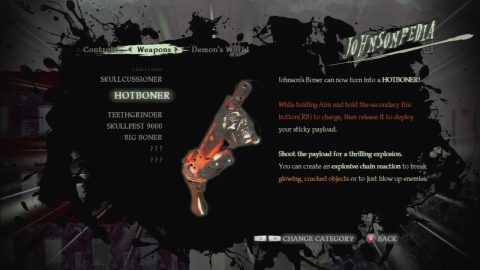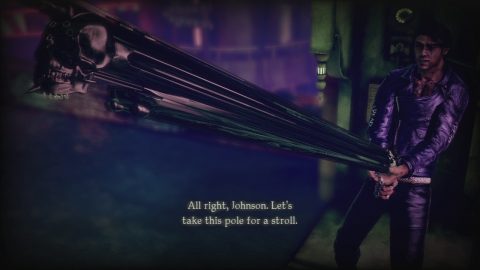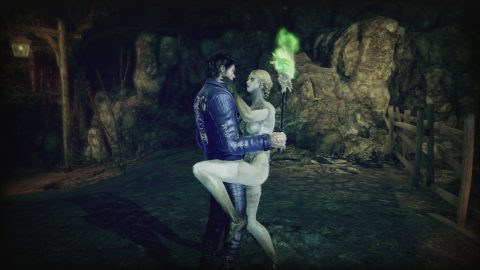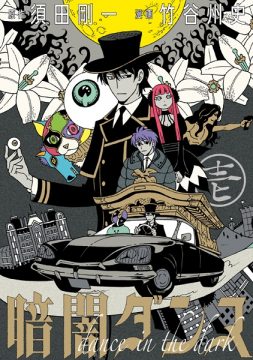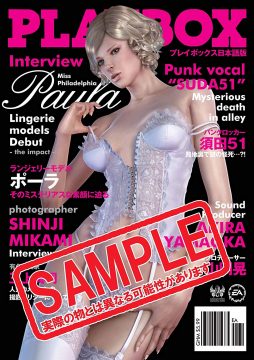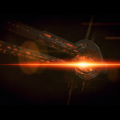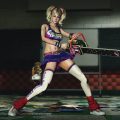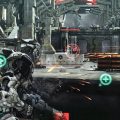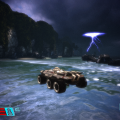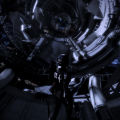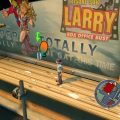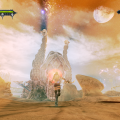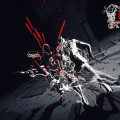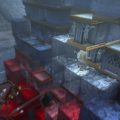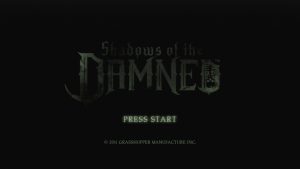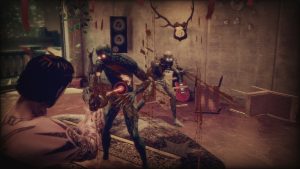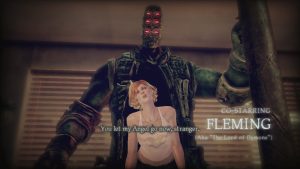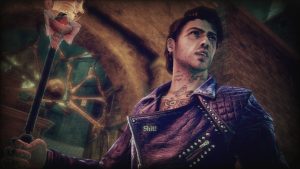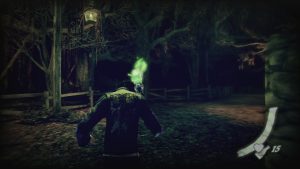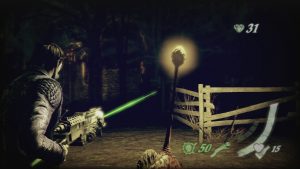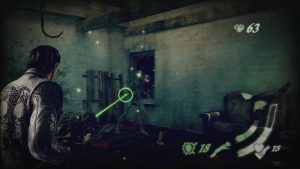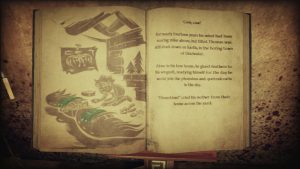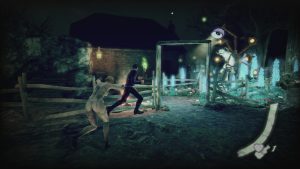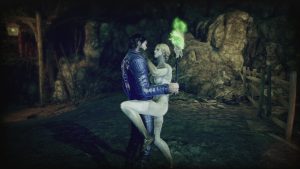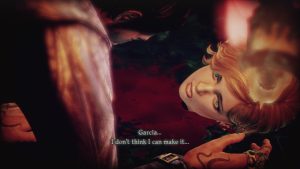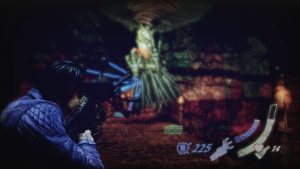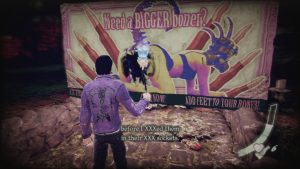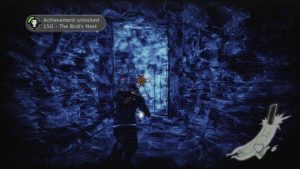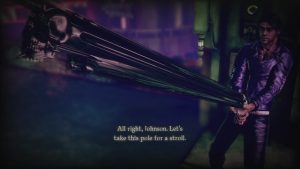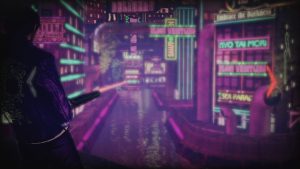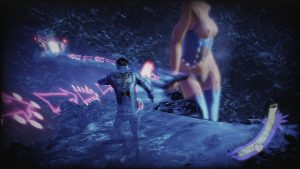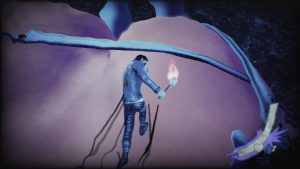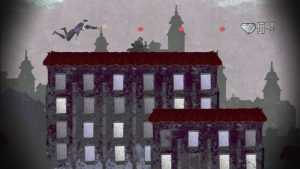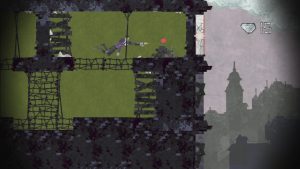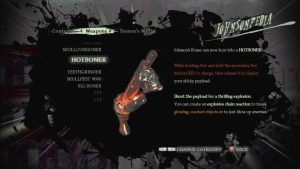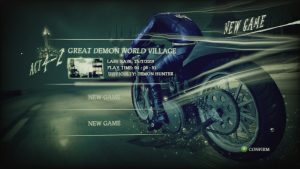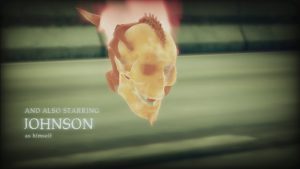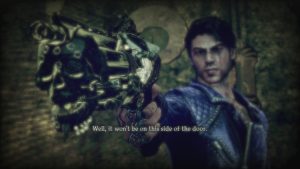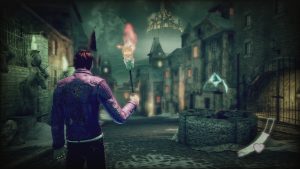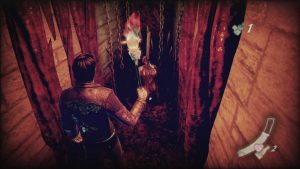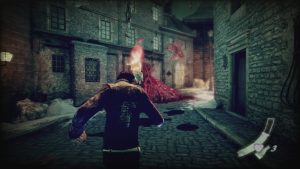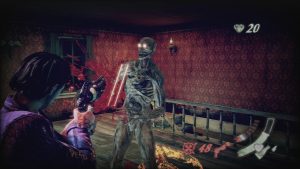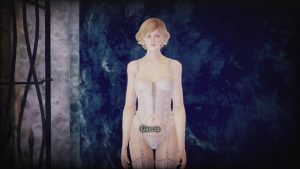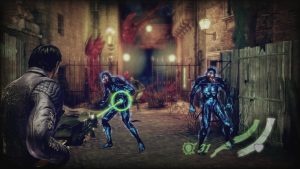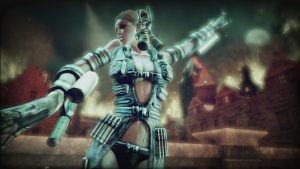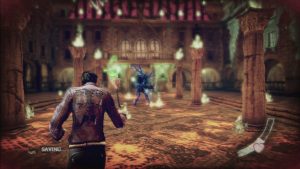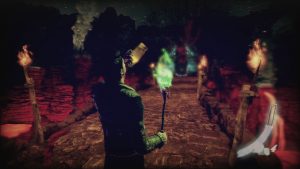What happens when you bring together the writer/director of killer7, the “grandfather of survival horror”, and the composer of what many call the scariest video game series of all time? A short romp through Hell filled with more dick jokes than you can shake a joystick at. Shadows of the Damned, formally announced at Tokyo Game Show 2010 would bring Goichi Suda (Suda51) and Shinji Mikami together for the second time since killer7 in 2005, this time bringing Silent Hill composer Akira Yamaoka to compose the soundtrack. The publisher that gave the world this dream team was none other than Electronic Arts, making the title the first of two games developed by Grasshopper Manufacture to be funded and published by a western source. EA would be publishing the title under the “EA Partners” label, which would see EA partner with outside developers (often independent) to create games, examples being Rock Band, Valve’s console releases, Bulletstorm, Brütal Legend, and Fuse. Unfortunately, something that quite a few games under this label have in common is a muddled development cycle, even going as far as changing games in their entirety. Shadow of the Damned‘s development (which will be discussed later) was no different.
Our adventure starts with the main character; foul mouthed Garcia “Fucking” Hotspur, Hunter of Demons (voiced by Steve Blum) coming home to his apartment after proving his namesake. Once home, he hears the scream of his one and only love, Paula. This begins a short tutorial on the basics of moving and shooting, only ending when he finds Paula, dead, hanging from a noose, cut wide open. The big bad of the title, The Lord of the Underworld, Flemming greets Garcia with intentions of taking Paula down to hell with him only bargaining with Garcia on the grounds that he admit his defeat and lack of virility in comparison. Garcia declines the offer, which has Flemming retreating back to Hell, Paula in his grasp. Garcia follows Flemming to Hell right before the portal closes. Shortly after, on a long highway, we are greeted by Johnson, a floating skull, who will be your multipurpose partner on the journey to save Paula.
The moment Johnson and Garcia interact the game starts to show its true colors. While the introduction gave off the pretense the title would be somewhat serious, one of the first conversations with Johnson and Garcia is about the top secret way to get to Flemming’s part of Hell, which of course Garcia found online. Garcia and Johnson have great chemistry, making their partnership seem sincere and not just a man and his “Boner”. The game doesn’t stop at referential humor and adds crude, occasionally juvenile jokes, with checkpoints being coils of feces that steam that come from a small flying demon called “One Eyed William”, and certain gates being referred to as “Demon Pubes”. Garcia is not the brightest man, often having trouble reading and pronouncing bigger words, forcing the more eloquent speaker, Johnson, to assist him or even counteract him. However, Johnson isn’t just a talking head or even the hot rod that Garcia rides for a brief period, he’s also your weapon. Subtlety is definitely not a strong point of Shadows of the Damned.
This journey in Hell is your basic Over the Shoulder Third Person Shooter, very similar to the style that Shinji Mikami would showcase in both Resident Evil 4, and later with The Evil Within. Something that sets your shooting apart from other TPS titles however is Johnson’s Light Shot, which is used for a handful of purposes, most commonly to stun enemies for easy potshots or an up-close finisher. Another mechanic in the title that gives it some flavor is Darkness. Demons love Darkness, the thicker the better. However, Garcia is only human and can’t survive in it for long. Using the Light Shot, Garcia can shoot through the darkness to activate light-posts or light expelling Goats. Unfortunately for Garcia, he must stay in the darkness in order to expose weak points for enemies or for links to the Demon Pube doors. Shooting is handled by three guns, all of which get upgraded during the trip though Hell; a handgun (The Boner), a shotgun (The Skullcussioner), and the machine gun (The Teether).
During Garcia and Johnson’s journey, they will occasionally come across higher demons. These demons, handpicked by Flemming, are souls who died in rather spectacular ways. Garcia finds books showcasing their life before Hell before facing off with each of these demons. It’s quite the cast; a man who ate to no fill, dying after eating his harmonica, a young boy attempting to fly, only to fail spectacularly, a masterful opera singer who starved herself, and a beautiful trio of sisters all falling into the same well. These books are read either by Garcia or Johnson, who usually have quips or comments about the events unfolding on the page. The books are noteworthy in that they contain one of the only instances of the word “fap”, internet slang for masturbation, in a video game.
On the gameplay side, these demons act as boss fights. Ranging from using explosive barrels to an entire set of levels leading up to a side scrolling shooter (that level, “Great Demon World Village”, is a reference to the Japanese title of Ghouls ‘n Ghosts), bosses aren’t lacking in how the fight plays out aesthetically, but more often than not, the action devolves into shooting a weak point until the boss dies. The reward for defeating these great demons comes in the form of Blue Gems, which can be used to upgrade your weapons. These change your “Boner” to a “Hot Boner” or even “THE BIG BONER”; the former allowing for explosive, gooey wads of light to destroy walls or armor, and the latter for a single chapter. The “Teether” has upgrades in the form of “The Teethgrinder” and “The Dentist”. “Skullcussioner” becomes “Skullfest 9000”, allowing multi-shot when charged, and then finally “Skullblaster”. Charging the Skullblaster no longer creates a multishot, but instead forms a bomb, which is mostly used at the end of the game for both bowling and pachinko minigames. Unfortunately, you cannot revert back to the previous versions of your weapons after these upgrades. Functionally the Boner and Skullcussioner both don’t change much outside of charge shots, the Teether changes rather drastically with its upgrades.
Your weapons aren’t the only part of the game that can be upgraded though, like every other shooter nowadays, Garcia can also be upgraded. Your health, how fast you can perform a melee attack, or even how quickly you shoot can all be upgraded. These upgrades are with Red Gems, of which you will either find, or purchase with white gems. A half demon named Christopher (voiced by the indelible Cam Clarke) sells you red gems, as he’s a rather pleasant and helpful demon, only having an insatiable taste for those white gems . Also for purchase is any ammo you might need or the game’s choice of healing items, ALCOHOLIC BEVERAGES!
Despite character and flavor exploding from every orifice of Shadows of the Damned, it is also a game that with rather fast pacing making a game that is brief to begin with feel even shorter. The start from Garcia’s apartment to the final boss can be a very short and smooth trip if you have any experience with third person shooters. Outside of a few confusing segments, the game is also not very difficult, made easier with upgrades and the stockpile of drinks you can accumulate.
It would be a disservice to not mention the soundtrack for Shadows of the Damned. Composed by Akira Yamaoka, the man behind many OSTs at Konami, most notably the Silent Hill series, Yamaoka left Konami in 2010 to join Grasshopper. While he contributed a handful of songs to the soundtrack for No More Heroes 2, Shadows of the Damned would be his first full soundtrack at the company. For fans of his work on the Silent Hill series, this OST does not disappoint, also having a very eerie, and unconventional sound. Fans of the vocal tracks in the series, by Mary Elizabeth McGlynn and Joe Romersa, will also not be disappointed as the game contains three songs with her vocal work and his lyricis. The game has over one hundred unique tracks, being displayed through normal gameplay, loading screens, menus, a song unique for the PS3’s XMB menu, with almost none of these being repeated. With as many songs at there are to be heard in the title, it’s fortunate that songs aren’t all limited to the same style or genre. Elevator Jingles, melancholic vocal performances by McGlynn, hard rock songs, jam sessions, and a few in particular which can’t be narrowed down to any specific genre. Yamaoka would also redo two songs from Silent Hill, “Ice” from Shattered Memories and “Last Mariachi” from The Room, however neither are heard in the game proper. “Ice” can only be found in the game’s files, going unused, and “Last Mariachi” was used as the song for when the game is waiting to be started on the XMB. Unfortunately, the complete soundtrack has never been officially released, with only a sampler released for preordering the title, and another truncated release that was for sale on the now defunct Grasshopper store.
Shadows of the Damned had the rotten luck of being the first title developed by Grasshopper under Unreal Engine 3 and it shows. Getting the good out of the way, Garcia and Johnson have very detailed models and texture work. This is in contrast to nearly every other model, which lack proper flair and contain numerous imperfections. The game also has a rather impressive use of lighting. Depending on which weapon you’re using, Johnson (as either a torch or as whatever gun you have out) will give off a colored source of lighting, unique from any other source in the environment, showing an artistic effort to not make the colors that Johnson takes on just visual cues. In spite of Garcia in particular having good texture work, very few of the other textures in the game seem polished, giving off an unfinished feel to them, with only a handful looking like they belonged on a current gen console. This is made even worse by the texture pop-in, somewhat of a common occurrence in Unreal Engine 3 titles. While the game runs at 30fps, in what can be assumed to be a choice from the developers to keep in line with most third person shooters, the game often has framedrops, and can downright stop in it’s tracks when you reach a checkpoint. Loading screens between each area can last longer than ten seconds, and are at times, prone to getting stuck and endlessly loading. All of these issues are magnified on the PS3, which is known to have issues with UE3. Something unique to the PS3 version is an odd muffling of the voice acting and music, an issue that is absent on the 360 version.
While Shadows of the Damned was formally announced in 2010, a year before it’s release, it had a quiet announcement years prior in Edge in 2006 as “Kurayami”, Japanese for “darkness”. Kurayami was planned to be more of an open game than SotD, placing you in a European village full of odd characters to interact with. The work of Kafka would be the place of inspiration for Kurayami, wanting more of a horror feel than most games. Much like the title suggests, darkness was a key component of the game. Shinji Mikami, who had previously worked with Grasshopper on killer7 would join development during this phase as a producer. In Mikami’s words in an interview for SotD, this was because “Grasshopper wasn’t really that good at the whole gameplay thing” and wanted someone who knew how to make a fun game. Suda and Mikami would search for publishers around this time and would settle on EA due to their ability to give the project a larger budget as they were one of the biggest third party publishers. In reality, EA funded the EA Partners projects using loans from banks, who would send payments to developers if certain deadlines were met on time… meaning that the bank would be paying for the game, not EA. This can even be seen in SotD‘s credits as First National Bank is given credit. In theory, this should mean that EA would be hands off in development. In pratice, this couldn’t be any further from the truth.
Kurayami as it was initially envisioned no longer existed. According to the “Art of Grasshopper” artbook, the title was turned down four times before EA would greenlight it. Points of contention would often be about the complexity of the title or the lack of a traditional firearm for the lead. One such pitch that did include a firearm had Paula, as a small woman, living inside of your gun who would work as Garcia’s partner. She would also pop out sometimes as a rabbit, but this was something EA would have an issue with, being confused by it. Paula in this incarnation of the title would be the basis for Johnson in the final release, your partner being linked to your gun. Suda51 mentions in the aforementioned artbook that EA told him about the “Elevator Pitch”, if you couldn’t sell your idea in the length of a elevator ride, Hollywood wouldn’t use it. EA wanted Hollywood from Grasshopper and it would eventually lead to the plot being tied to a love story.
EA would bring in their own man, Massimo Guarini, to assist in development a year into their partnership. Guarini would become the lead director of the title, despite what marketing, including the game’s own packaging would tell you. Under Guarini’s direction, the game became the generally non-serious title it released as. Kurayami was dead and Shadows of the Damned took its place. Under Guarini, the game finally was something that EA would accept, saving the title from becoming just another unreleased game. The title was becoming something that had more of an appeal for wider audiences. In the end however, this didn’t pay off. While Shadows of the Damned received mostly positive reviews, its sales were another thing entirely. Selling less than 30k copies at release with both consoles combined, and less than 10k copies upon its Japanese release. All of those changes, all of the development troubles, for nothing.
Up until only recently, Suda51 was very quiet about Kurayami becoming Shadows of the Damned, or even having a troubled development, even denying that Kurayami was in development multiple times before SotD was announced. It wouldn’t be publicly known that the game had a rocky development until Shinji Mikami mentioned in an interview after the game’s release that Suda had to constantly re-write and refocus the title, with SotD not being a thing like his original plan. Mikami would liken it to Suda’s heart and will being broken down each time EA would turn down his ideas. Fortunately, the ideas for the earlier drafts of the game would not go wasted. The first draft, the one before EA got involved, would become a manga released in 2015 named Kurayami Dance. The second draft would be used for a future Grasshopper title named Black Knight Sword as confirmed by Suda51.
Shadows of the Damned is a game damned by its circumstance. Marred by a studio and publisher who had no clear vision on what they wanted the game to be and lack of experience in the tools given. Coming after the release, none of the key people involved had explicitly positive things to say about their experience outside of Akira Yamaoka, who even had ideas for a potential sequel. Shinji Mikami has gone on record, saying that the best part about development was Grasshopper learning how to use Unreal Engine, which would be their engine of choice going forward, with better results. Despite all the flaws, the game is still an enjoyable, albeit brief game with an atmosphere that is difficult to match. Even with the RE4 esque shooting making for good, if not derivative gameplay mechanics, it does end up feeling much like every other title from Grasshopper, style over substance, with said style more than making up for lack of substance.
Like many of these hyper violent titles, the international version is a bit gorier than the Japanese release. In the sections where you run past (and eventually across) the giant naked dancing Paula, she’s topless in the international version but covered in the Japanese version.
